Introduction: Wiring Sockets
Step 1: The Socket
[sok-it]
noun
Electricity. a device intended to hold an electric light bulb mechanically and connect it electrically to circuit wires.
---------------------------------------
As the dictionary states, sockets are the devices that deliver electricity to the bulbs. Power reaches the bulb by running through the metal tab at the bottom of the socket (via the Hot wire), where the bulb sits, through the bulb, and back out the metal threads where the bulb is screwed in (via the Neutral wire), creating a circuit.
Historically, traditional incandescent lighting has used 4 different sized sockets:
- Candelabra (E-12) base - think chandelier bulbs and vintage Christmas lighting
- Standard Edison or Medium (E-26) base - regular incandescent light bulb size
- Intermediate (E-17) base - uncommonly used for interior lamps
- Mogul base - these are for HUGE bulbs that are no longer in vogue, used mostly in vintage floor lamps
We will be using Standard Edison (E-26) based sockets exclusively in this class, but the wiring techniques taught will also apply to the other socket sizes if you feel like experimenting once the class is done.
There are two main categories of Standard Edison sockets that we'll focus on: metal cap and shell style and threaded phenolic sockets with shoulders.
Step 2: Metal Cap & Shell Sockets
This classic socket style is made up of 4 parts:

Some shells have uno threads that are used for screwing on uno style shades or shade holders.

Cap and shell style sockets offer the most variety of built-in switches. (The Keyless socket on the far left has no switch.)

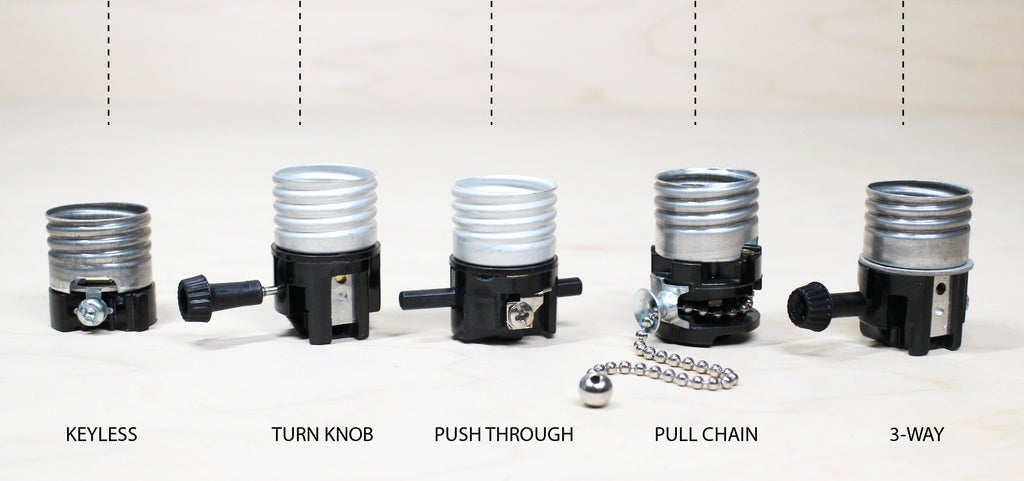
* 3-Way inserts are for 3-way bulbs.
The following is the Hot & Neutral anatomy of inserts.
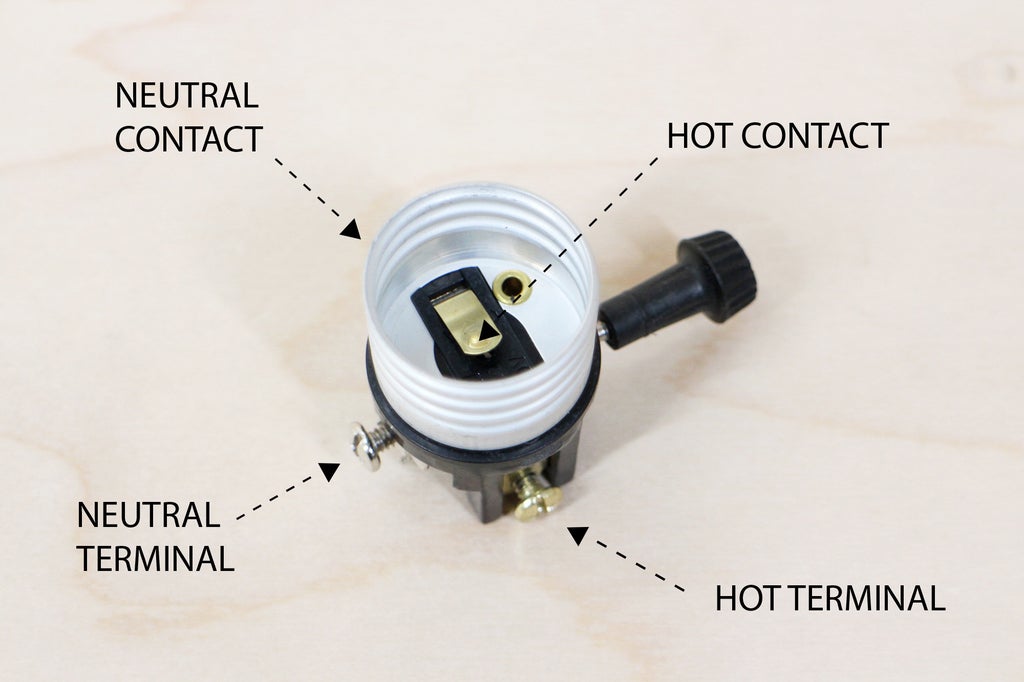
Here's the journey that energy takes to light up a bulb:
- Electrical current flows from the power box to the outlet which is contact with the plug.
- From the Hot/Narrow plug prong it flows to the Hot wire of the cord.
- The Hot wire is connected to the Hot terminal screw of the socket.
- The current flows from there to the metal tab in the center of the socket that is the Hot contact.
- This piece is what makes contact with the bottom tip of light bulbs, sending the electrical current into the bulb, lighting it up.
- The current flows through the bulb and exits through the bulb's threads, that are touching the threads of the socket, which is the Neutral contact.
- From there the current flows to the Neutral terminal screw and onto the Neutral wire of the cord which takes it to the the plug - that sends it back to the power box. Phew!
The socket is a major player in this process. Go sockets!!
Step 3: Phenolic Sockets (w/ Threads, Shoulder, and Ring)
Made of phenolic resin (also used to make billiard balls, pot handles, and many other household goods), these sockets are most commonly used in pendant lights. They are easy to wire and their broad 'shoulders' are great for holding many different shade options, allowing you to create many different looks.


Even though they look like distant cousins, these sockets play the exact same role in supporting the electrical current as the metal cap and shell sockets do. They're more like, brothers from another mother.
Step 4: Wiring the Sockets
Lay out your two foot lamp cord pieces (x1 SPT-1 and x1 SVT) along with all the parts that will make up your practice cord sets.

SPT-1 Cord Set Parts
- 2 feet of SPT-1 lamp cord
- 1 medium (Edison/E-26) base metal cap and shell socket
- 1 rotary single pole on/off line switch for SPT-1 cord
- 1 polarized Leviton's Kwik Easy lamp plug or any easy plug for 18/2 SPT-1 wire
- 1 threaded 1/8 IP nipple, 3-4" long

SVT Cord Set Parts
- 2 feet of 18/2 or 18/3 SVT plastic or cloth covered cord
- 1 medium base phenolic socket, threaded w/ shoulder and ring
- 1 single pole rocker switch w/ screw terminal wire connections for use with SVT cord
- 1 polarized antique reproduction lamp plug w/ screw terminal connections for use with 18/2 twisted and SVT cord, or 18/3 SVT cord
- 1 small metal strain relief
Next, grab the following from your toolbox:

- wire cutters
- wire stripper
- box cutter
- phillips head screwdriver
- small flathead screwdriver
- ruler
- Elmer's glue
- needle nose pliers
- small channellock pliers (not pictured)
- electrical or masking tape
- continuity tester or multi-meter
Step 5: Wiring the SPT-1 to Its Socket

NOTE: As a general rule for all sockets, the Hot wire goes to the brass terminal, and the Neutral wire to the silver terminal.
Ok, let's get started! First, separate the socket's cap and shell and remove the interior socket. (like pictured above)

Then screw the threaded nipple into the bottom of the socket cap* as far as it will go and set aside. (You may need to unscrew the small screw on the side in order to do this.)
Why the threaded rod? This type of socket is used with SPT-1 cord primarily on table lamps and in these cases, the socket would be secured to the lamp base before wiring occurs. This threaded rod, or nipple, is being used for this exercise to make it easier to hold onto the cap while securing/connecting the shell (which requires some pressing force) and to remove it once this exercise is complete so you can reuse the socket.




Use wire cutters to snip in between the two parallel wires, being careful to only cut the connecting insulation and not the wires. Pull the two wires about 3 inches apart.
We're going to tie something called the Underwriter's (or Electrician's) Knot. Follow along with the photos - and I would suggest untying and tying it a few times to commit the sequence to muscle memory.








This knot acts as a strain relief and helps protect the wires from ever getting pulled out of the socket terminals. Example: If a lamp fell and was grabbed by the cord to stop it from falling. This pull force could be enough to compromise the wire/terminal connection, but the Underwriter's Knot prevents this from happening by being too wide to get pulled through the lamp pipe. This knot drops the mic like nobody's business.


Next, cut the wires so that they are about 1" long.


Using the 16 gauge holes of your wire strippers, strip 5/8" of the insulation off of each wire.


Spread the copper strands into little fan shapes and use your thumb and index finger to twist the strands together.

Trim the wires at this point if needed to make sure that they're approx. 5/8" long.

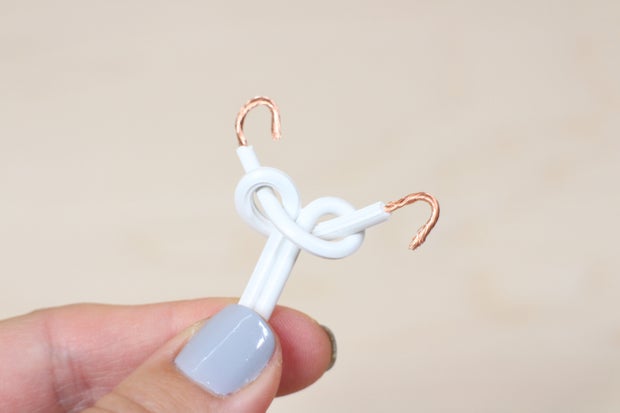
Bend the wire ends into 'U' shapes from left to right, or clockwise.

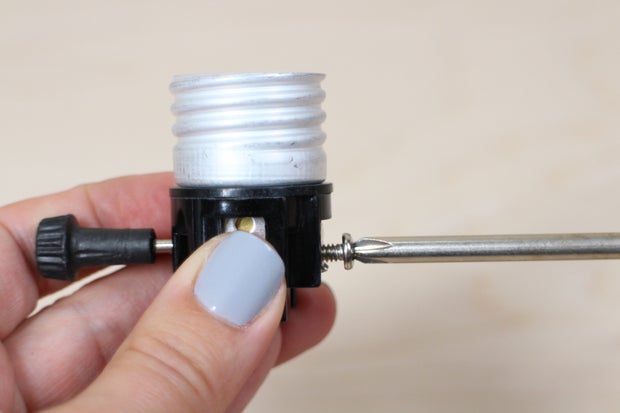
Before we can connect the wires to the socket terminals, we need to make sure the terminal screws are unscrewed all the way. Use your phillips head screwdriver to make this magic happen.



Starting with the Hot (Smooth sided) wire, place the bent wire end over the threads of the brass (Hot) screw terminal on the socket. Hold it so that wire insulation starts just below the screw head and lines up with the screw center.
Use your small flathead screwdriver to tuck the wire neatly behind the screw head. Hold the cord in place with your non-dominant hand and tighten the screw with your dominant. I like to use my small flathead screwdriver for this also, so that I can tuck any runaway wire strands back in place as I tighten.
If your first attempt looks unruly with wire strands poking this way and that, undo the screw and try again. Keep at it until you achieve a tidy connection. There should be no strand stragglers and little to no exposed wire below the terminal screw head. Why? A tidy connection is a safe connection.

When all of the wire end isn't in contact with the terminal screw, this means that less wire has to handle the same amount of load (electrical current/ energy) that's flowing through the wire. The chances of it causing a fire are low, but it's not ideal.

If you have long dangling wire that is sticking down below the socket, it increases the risk of live metal touching something that isn't insulated. Again, given the improved design of modern sockets, the risk of this happening is very low, it's better to be tidy than sorry.
Once you've perfected the technique, do a finishing tightening with the phillips head screwdriver for good measure while holding the cord firmly in place below the screw.


Repeat this process for the Neutral wire and silver terminal.

This is what you want the finished product to look like: tidy wires and tight screws!



Now to put the socket interior's outfit on: the cap and shell. Thread the other end of the lamp cord into the cap and threaded rod like pictured. Slide the cap up until the knot and bottom of the socket are nestled into the cap.



Slide the insulated shell over the socket and while holding firmly onto the threaded rod and cap, snap the shell in place by first pushing in and down where it says 'press' (just to the right of the switch slot) until you hear -- and feel -- a click. Then repeat on the direct opposite side of the shell. There should be another 'click', securing the cap and shell together.


Unscrew the threaded rod from the cap and slide it off the cord. Keep it handy as we'll use it again once we've finished the cord set and need to take the socket apart for re-use.
Great job!! You now know how to wire one of the most commonly used sockets. It's to the moon for you now. OR it's on to wiring the next socket style to get even more bad ass-ness under your belt. Take a little break and we'll meet back here in 10 for the next socket. :)
Step 6: Wiring the SVT to Its Socket

With this next cord set, both the cord and socket differ from the ones we just used. The cord is slightly more difficult to work with and the socket, a bit easier. So in a way it evens out. :) This combo of cord and socket are used predominantly for pendant lamps.
Ok, let's get going. Sound the bell for round No. 2!


Measure and mark 1 1/4" from one of the cord ends. Then cut a 1 1/2" long piece of either electrical or masking tape and wrap it around the cord leaving the 1 1/4" exposed like pictured. The tape prevents the cloth cover from fraying while you wire up the socket.

Either holding the cord in your hand, or placing it on a cutting mat, carefully use the box cutter to gently cut through JUST THE CLOTH COVER all the way around and along the edge of the tape.

You may be able to slip the cover off at this stage, but if not (some cords use a light adhesive to secure the cover), lay the cord of a cutting mat and cut lightly along the length of cord end in order to remove the cloth -- following the above instructions -- to avoid cutting through the Hot or Neutral wire.
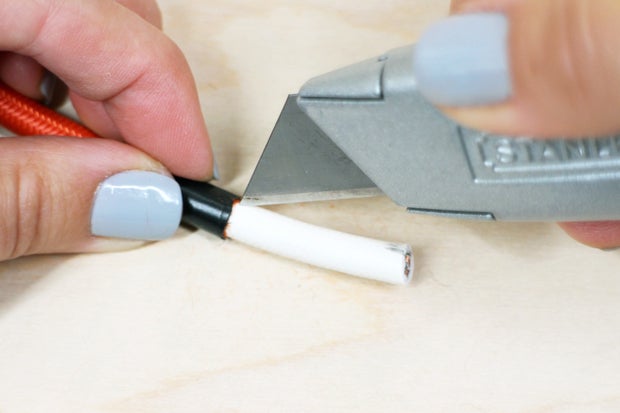

Once the cloth cover has been removed, place the exposed cord end back down on a cutting mat or work table, again, so that the two wires (Hot and Neutral) are parallel to the table, or in the case of my 18/3 cord, so that the green ground wire is facing the ceiling.
Use the box cutter to cut along the cord through the outer insulation from the tape to the end, being very careful not to cut into the hot and neutral wires (it doesn't matter if you cut into the green ground wire as we'll be cutting it off anyway), until you can peel it open exposing the coated wires within.


If you have trouble peeling off the insulation, use the box cutter to gently make a cut parallel to the tape at the intersection of your first cut (again being careful not to cut into the white or black wires).
The insulation should peel off easily now. You will be left with exposed Hot (black) and Neutral (white) wires (and maybe like me, also a green ground wire) along with some insulation fibers.



Cut off the fibers at the tape. If you did use 18/3 cord and have a green ground wire, cut that off also. This will leave you with just the Hot and Neutral wires.

Using the 16 gauge holes on your wire stripper (I find the smaller 18 gauge holes cut some wire strands off along with the insulation), strip 3/8" insulation off the ends of the wires. We're removing less than we did for the last socket as the connection is made in a different way than with the metal cap and shell socket.

Fan

and Twist
Fan and twist the wire strands as we did with our first socket.


Use your fingers or needle nose pliers to fold the twisted wires in half.



The finishing touch on the cord is to gently remove the tape, apply a dab of Elmer's glue to the end of the outer insulation, then use your finger to run the glue all the way around the end of the cloth cover, trying to keep the glue as close to the cut end as possible so that the cord that sticks out of the bottom of the socket is kept clean and great looking. Using the glue keeps the cloth cover from fraying in a super subtle way.
Let the glue dry for 5 minutes before moving on to the next step.


Next, slide the socket cap over the stripped end of the cord before we wire up the socket interior. I know that our cord for this set is only 2' long, but once you're making cord sets that are 15' long, you'll sure wish you had remembered to put the cap on first so you don't have to slide it all the way up from the other end! It's just a good habit to get into.


Now that the wire ends are prepped, it's time to connect cord to socket! Here's the low down on the phenolic socket interior and how the wires line up with it. (NOTE: the Neutral terminal is behind my thumb in the above left image!!)


I find it helpful to bend and shape the wires to make the ends line up easier with the terminals.

Make sure the terminal screws are unscrewed all the way before trying to insert the wire ends.


Insert the Hot wire end into the socket terminal hole that corresponds with the Hot center metal tab on the opposite side of the socket. Tighten that terminal screw. Repeat for the Neutral wire end in the terminal hole that corresponds with the Neutral outer metal tab. Tighten that screw too.

Great work! We're almost done this lesson!

Now we're going to add a strain relief. This 'wider-than-the-cap-hole' piece of hardware crimps down on the cord insulation, protecting the wire/terminal connections -- much the same way the Underwriter's Knot does for SPT-1 cord -- and supporting the weight of the shade once added to the socket.





Set your small Channellock pliers on the middle size setting and place the strain relief in its grasp. Place the strain relief as close to the top of the outer cord insulation cut line as possible (like pictured) and squeeze it in place. Change the pliers to the smallest size setting and give it another good squeeze to make sure it's got a good, tight hold of the cord insulation.






Slide the cap up to meet the socket interior so that it nestles into the cap. (You might have to rotate the socket until the two parts align correctly.) Then screw on the shell. It may take a bit more twist power as the cap and shell get closer to each other. You will hear and feel little clicks which are locking the two pieces together. (Don't worry, I'll show you how to take them apart once we're done the sets so you can reuse the socket!)
Step 7: Quiz Time!
{
"id": "quiz-1",
"question": "What type of socket will we be using exclusively in this class?",
"answers": [
{
"title": "Mogul base sockets",
"correct": false
},
{
"title": "Chandelier (E-12) base sockets",
"correct": false
},
{
"title": "Standard Edison or Medium (E-26) base sockets",
"correct": true
},
{
"title": "Intermediate (E-17) base sockets",
"correct": false
}
],
"correctNotice": "You wore your smart pants today!",
"incorrectNotice": "Sorry friend, that's incorrect"
}
{
"id": "quiz-1",
"question": "What is the paper insert called that slides into the metal socket's shell?",
"answers": [
{
"title": "A barrier",
"correct": false
},
{
"title": "A conductor",
"correct": false
},
{
"title": "An insulator",
"correct": true
}
],
"correctNotice": "That's correct! This important safety piece is a non-conductive barrier that protects the live wire connections from coming in contact with the metal shell.",
"incorrectNotice": "That's incorrect! Try again."
}
Step 8: Way to Sock It to the Sockets!
Now that you're a pro at wiring sockets, it's time to move on to the next lesson and wire the plugs. Let's do this!!




